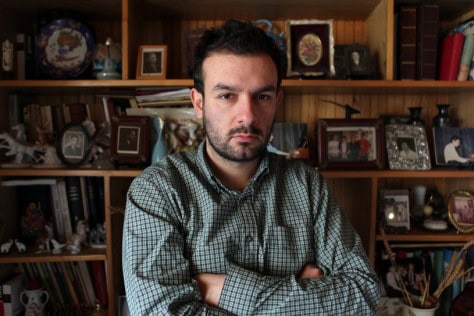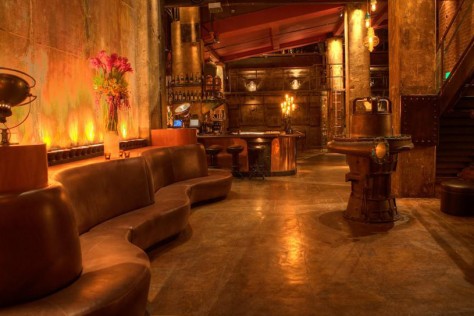In the winter of 2004–2005, Stu Sherman traveled to Kosovo to photograph the region and interview the young artists and musicians living in the cities there. He arrived nine months after riots reshaped the physical and political landscape of the area, and he worked mainly in the capital, Pristina. As of this writing, the final status of Kosovo is still unsettled. Serbian politicians refuse to recognize the right to an independent, sovereign Kosovo, despite pressure from the U.N. Talks to reconcile the Kosovar and Serbian views have repeatedly failed.
Of Islam and Santa Claus
The predominant religion in Kosovo is Islam. While the region houses many important sites for Serbian Orthodoxy, like the Petrarch (the equivalent of the Vatican), there are also many mosques dating back to Ottoman times. While strongly traditional, the practices and beliefs of the Kosovar Albanians are also very indigenous to the region.
A rapper named Rrusta informed me that Wahhabists were paying people to practice Islam, attend mosque and pray five times a day. A former proponent of violence, he had risen to popularity with a track he released with his group Jericho Walls. Entitled “Don’t Fuck With Albanians,” the 1998 single was an English-language rap recorded in the impassioned style of Rage Against the Machine. It told the story of a Kosovar expat in Europe who had become a criminal in order to support the resistance. Since the war, Rrusta has become a practicing Muslim, though he abhors the foreign Islamists who are trying to impose their version of the religion on Kosovars. “Islam is like water,” he told me. “It has unique properties but takes the shape of the vessel you put it in. Those people are giving it to us in a certain shape and saying, ‘This is Islam.’”
Oddly enough, many Kosovars seem to celebrate Christmas, or at least they had photos of Santa everywhere. It seems to me that they were celebrating it as an imported Western holiday, so they just threw all the commercial aspects of it into one giant, poorly translated jumble. New Year’s was an important holiday, and on the televised New Year’s “spectacular,” they had a Santa figure dancing around, surrounded by people in traditional clothing and women in skimpy, shiny skirts lip-synching pop songs. It was very surreal.
Battles on the Bridge
Children play soccer along the Ibar River in north Mitrovica. Mitrovica was formerly an integrated urban area in North Kosovo. A mining town during the Yugoslav era, it was the location of one of the most vibrant rock scenes in the Soviet bloc. Ibar separates the city into Serbian (north) and Albanian (south). North Mitrovica is the last Serbian urban area in Mitrovica. The Serbs that have not left Kosovo all live in enclaves since riots in 2004 forced their evacuation. The riots were sparked by reports, which were never validated, that three Albanian children had been drowned by Serbs in the Ibar River. U.N. forces heavily guard the bridge, and only a handful of people not working for the U.N. cross the bridge now. I was one of them.
I met a Serbian punk band, Hosenfefer, on the north side of the river. Over rakia, a homemade brandy that ranges in flavor from “sweet” to “lighter fluid,” they told me that you know things are getting dark when rock bands refuse to play outside their own ethnic group. One of Hosenfefer’s former drummers was injured numerous times, incurring a concussion during one of the conflicts that occurred at the bridge. The band members themselves were still scarred from the riots and were vehemently opposed to an independent Kosovo, fearing what the Albanians might do if put in charge.
The Art of Guerrilla Warfare
The first attacks the Serbs launched at Kosovo’s Albanian population (which comprises 90% of the people in the region) were aimed directly at their ethnic identity. They shut down culture. Where once there were outlets for music, poetry and art, it became criminal to use one’s own language and draw from one’s own culture. These were dark times for a formerly vibrant region, though it left a few avenues open for resistance and the establishment of a strong Albanian identity.
The independent, avant-garde rock ’n’ rollers of the post-Soviet era encountered a bleak world. In the mid-90s, as Milosevic’s forces combined with paramilitary groups and began directing their attacks at the population, the Albanians fought back by forming the Kosovo Liberation Army (KLA). These compatriots of the Kosovar artists were only interested in easily and bluntly identifiable forms of cultural expression that essentially amounted to agitprop. The KLA was an armed force of guerillas that were considered terrorists by the Serbians and the U.S. until 1997. (The U.S. stance was based upon the illegal means they used to raise money, including heroin trafficking). They attacked Serbian forces, but mostly in small battles when they wouldn’t have to face a larger force. Meanwhile, the Kosovar artists were attacked physically—and politically, through censorship—by the Serbs (for being Albanian) and by their compatriots (for not being patriotic enough).
An Exodus Beneath the Bombs
In March of 1999, NATO began bombing military targets in Serbia and Kosovo in an effort to get Serbian forces out of Kosovo and replace them with international peacekeepers. When the bombing began, Serbian military and paramilitary groups stepped up their violent campaign against the Kosovar Albanians, 300,000 of whom fled to neighboring countries like Macedonia.
I talked with a musician named Ditro, a Kosovar Albanian whose band Por-no was one of the few remaining alternative bands in Pristina. We met in the studio where he produced his recent album, which was reminiscent of an ambient Radiohead. It was daytime on New Year’s Eve, and we were both on edge as fireworks and the occasional celebratory gunshot went off outside. Ditro had escaped to Budapest in ‘99, the same day the NATO bombings started. “I watched CNN broadcast everything live,” he said. “The lights went off, and Pristina was just a shadow. Then the bombs started. I got drunk that night in Budapest, and we all felt good because our oppressors were getting their ass kicked. My family woke up the next day with a group hangover, so there were no more parties. Who knew how long we could stay in Budapest? Would they deport us? Would we ever have a home to go back to? I went to Skopje [the capital of Macedonia], where most of us fled to, and found it incredibly depressing. Everyone was working as translators for news agencies, covering the war during the day and getting dressed up and going out like it was a normal night in Pristina. They wouldn’t talk about what happened, wouldn’t tell their stories. They were in denial, wanting to be cool or forget the traumatic experience with their $100 a day from news agencies. That’s what the war did to people. That denial still exists today. It’s like they want to start over and erase ten years.”
It’s important to note that the Kosovo conflict is still active in people’s minds and that fighting has spilled over onto the Internet. There are a lot of sites with misinformation or incredibly biased information that tries to “report” atrocities committed by the other side. For a pretty good account of the war, events leading up to it and the aftermath, the NGO Human Rights Watch has a book online at hrw.org/reports/2001/Kosovo that I recommend. Useful resources can be found at unmikonline.org , which is the U.N. Mission in Kosovo (the current governing and policing body in the region). Also, Matthew Collin’s Guerrilla Radio: Rock ‘N’ Roll Radio and Serbia’s Underground Resistance is a great book that tells the story of an underground radio station and political resistance in Belgrade amongst young musicians, artists and DJs.
 Q&A with Larry Gus
Q&A with Larry Gus We Own the Night: The Edison
We Own the Night: The Edison
No Comments